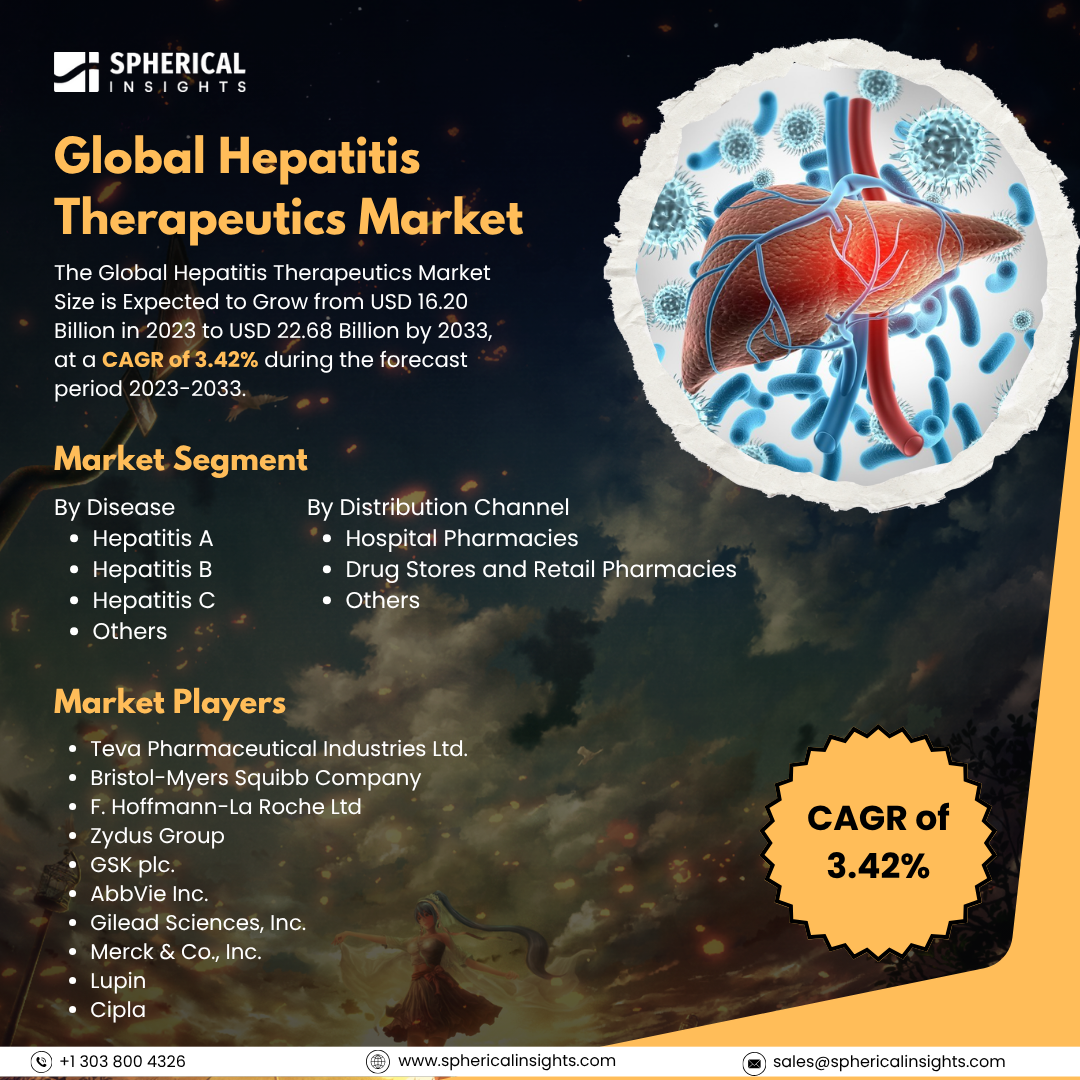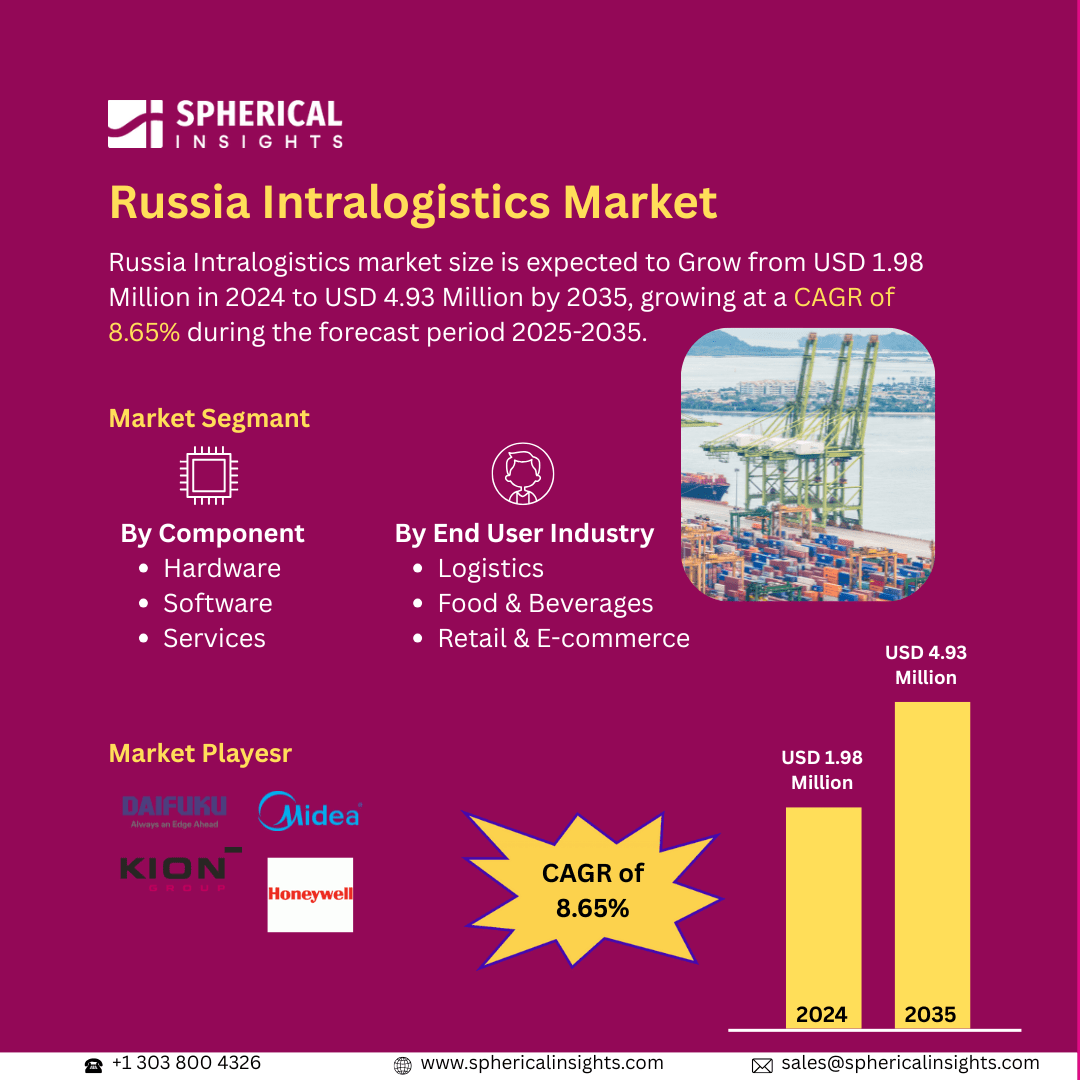Global Hepatitis Therapeutics Market Size to Exceed USD 22.68 Billion by 2033
According to a research report published by Spherical Insights & Consulting, The Global Hepatitis Therapeutics Market Size is Expected to Grow from USD 16.20 Billion in 2023 to USD 22.68 Billion by 2033, at a CAGR of 3.42% during the forecast period 2023-2033.
Browse 210 market data Tables and 45 Figures spread through 190 Pages and in-depth TOC on the Global Hepatitis Therapeutics Market Size, Share, and COVID-19 Impact Analysis, By Disease (Hepatitis A, Hepatitis B, Hepatitis C, and Others), By Distribution Channel (Hospital Pharmacies, Drug Stores & Retail Pharmacies, and Others), and By Region (North America, Europe, Asia-Pacific, Latin America, Middle East, and Africa), Analysis and Forecast 2023 – 2033.
The hepatitis therapeutics market is the worldwide industry dedicated to the development, manufacturing, distribution, and marketing of medications and treatments for the different forms of hepatitis, such as hepatitis A, B, C, D, and E. The market comprises antiviral drugs, immunoglobulins, interferons, vaccines, and combination treatments aimed at controlling and healing hepatitis infections, avoiding complications such as liver cirrhosis and cancer, and enhancing patient performance. Furthermore, the market for hepatitis therapeutics is fueled by the growing prevalence of hepatitis B and C, growing awareness, better diagnostics, and government support. Technological innovation in antiviral drugs, combination therapy, and the use of direct-acting antivirals (DAAs) drive growth. Increased healthcare infrastructure, R&D spending, and the need for affordable treatments also drive market growth globally. However, the high treatment costs, limited access in developing regions, adverse drug effects, stringent regulatory approvals, patent expirations, and low awareness in underserved populations are key restraints for the market's growth.
The hepatitis C segment accounted for the largest share in 2023 and is anticipated to grow at a significant CAGR during the forecast period.
On the basis of the disease, the global hepatitis therapeutics market is classified into hepatitis A, hepatitis B, hepatitis C, and others. Among these, the hepatitis C segment accounted for the largest share in 2023 and is anticipated to grow at a significant CAGR during the forecast period. The segmental growth is propagated to high disease prevalence, increased awareness, and advancements in antiviral therapies like direct-acting antivirals (DAAs). Growing government initiatives, improved diagnostics, and rising treatment adoption further drive significant CAGR growth during the forecast period, enhancing accessibility and patient outcomes globally.
The hospital pharmacies segment accounted for the greatest share in 2023 and is anticipated to grow at a substantial CAGR over the forecast period.
On the basis of the distribution channel, the global hepatitis therapeutics market is segmented into hospital pharmacies, drug stores & retail pharmacies, and others. Among these, the hospital pharmacies segment accounted for the greatest share in 2023 and is anticipated to grow at a substantial CAGR over the forecast period. The segmental growth is boosted by the increasing number of hepatitis cases, improved access to advanced therapies, and reliance on hospitals for specialized treatment. Rising healthcare infrastructure, better patient adherence programs, and hospital-based distribution of high-cost antiviral drugs further drive its substantial CAGR growth during the forecast period.
North America is projected to hold the largest share of the global hepatitis therapeutics market over the forecast period.
North America is projected to hold the largest share of the global hepatitis therapeutics market over the forecast period. The regional growth is attributed to high disease prevalence, advanced healthcare infrastructure, and strong government initiatives. Widespread access to innovative treatments, increasing awareness programs, favorable reimbursement policies, and significant R&D investments by pharmaceutical companies further contribute to the region’s leading market share during the forecast period.
Asia Pacific is expected to grow at the fastest CAGR growth of the global hepatitis therapeutics market during the forecast period. The regional growth is attributed to rising hepatitis prevalence, increasing healthcare investments, and growing awareness. Expanding access to advanced treatments, government initiatives, improving healthcare infrastructure, and a large patient pool further drive market growth, making the region a key focus for pharmaceutical companies.
Company Profiling
Major vendors in the global hepatitis therapeutics market are Teva Pharmaceutical Industries Ltd., Bristol-Myers Squibb Company, F. Hoffmann-La Roche Ltd, Zydus Group, GSK plc., AbbVie Inc., Gilead Sciences, Inc., Merck & Co., Inc., Lupin, Cipla, and others.
Key Target Audience
- Market Players
- Investors
- End-users
- Government Authorities
- Consulting and Research Firm
- Venture capitalists
- Value-Added Resellers (VARs)
Recent Development
- In February 2024, the development of GSK plc's bepirovirsen as a treatment for chronic hepatitis B was given top priority by the U.S. Food and Drug Administration (FDA). To verify its efficacy, this medication is undergoing phase 3 clinical trials.
Market Segment
This study forecasts revenue at global, regional, and country levels from 2023 to 2033. Spherical Insights has segmented the global hepatitis therapeutics market based on the below-mentioned segments:
Global Hepatitis Therapeutics Market, By Disease
- Hepatitis A
- Hepatitis B
- Hepatitis C
- Others
Global Hepatitis Therapeutics Market, By Distribution Channel
- Hospital Pharmacies
- Drug Stores and Retail Pharmacies
- Others
Global Hepatitis Therapeutics Market, By Regional
- North America
- Europe
- Germany
- UK
- France
- Italy
- Spain
- Russia
- Rest of Europe
- Asia Pacific
- China
- Japan
- India
- South Korea
- Australia
- Rest of Asia Pacific
- South America
- Brazil
- Argentina
- Rest of South America
- Middle East & Africa
- UAE
- Saudi Arabia
- Qatar
- South Africa
- Rest of the Middle East & Africa



